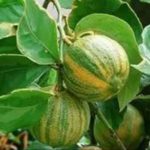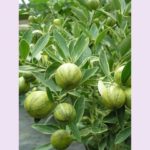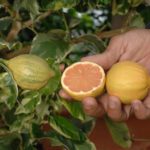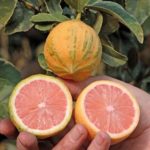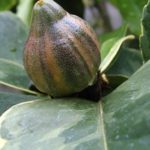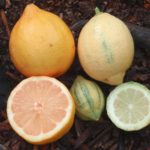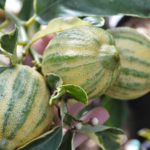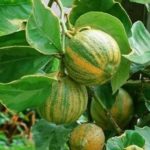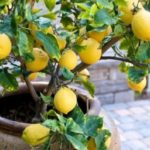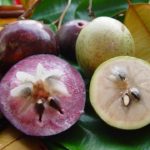Household citrus plants attract many amateur gardeners. They have an attractive appearance, have beautiful fragrant leaves, and bloom spectacularly. In addition, citrus fruits are capable of producing a small harvest of tasty and healthy fruits. But the variegated indoor lemon Eureka also has original colors of foliage, flowers and fruits, which makes it an even more desirable acquisition.
History of the variety, significance in culture
The variegated, or variegated, Eureka lemon is a variation of the original plant of the same variety. It has a long history, it was known in the middle of the nineteenth century. At that time, lemon trees were grown in the greenhouses of European kings and nobility..
In the second half of the 19th century, the plant came to the USA, where it was cultivated in warm states - California and Florida. Selection work was also carried out there. By selecting plants with unusual variegated leaves, a new variety of the old variety Eureka, variegated, was obtained. It instantly became a favorite among thousands of connoisseurs of indoor and greenhouse citrus fruits around the world.
Description and characteristics of the plant
Eureka lemon is a compact plant up to 50 centimeters high. In indoor conditions, in greenhouses and conservatories, this is a completely full-fledged tree up to 170 centimeters tall. The dark green leathery leaves characteristic of all citrus fruits have an original variegated color.
The crown is spreading, the branches tend to stretch out greatly, so the tree needs shaping and pruning. The branches are thin, drooping, and when loaded with fruits take on a “weeping” shape.
During the formation of buds, the lemon becomes even more beautiful, as the future flowers are painted in lilac, pinkish and violet tones. When blooming, the flowers gradually change their color from soft greenish to pure white. They have a pronounced citrus aroma, which is very much appreciated by lovers. Like most other members of the family, on the tree you can simultaneously see buds, open flowers, and ripening fruits.
Like everything else in this variety, the ovaries of Eureka variegata also have an original color. They are formed at the ends of the shoots, in the initial stage of development they are green, then they become striped with yellow sectors gradually appearing. A ripe lemon is almost yellow, with a thick, porous peel, the zest of which exudes a delicate aroma. But the most remarkable thing is the pulp of the fruit. It has a pink tint, which made it possible to give the plant a second name - Pink lemon.
Advantages and disadvantages
The advantages of multi-colored Eureka are clearly worth paying more attention to.
Application, beneficial properties
The Eureka variegated lemon has several uses:
- As a decorative indoor plant.
- For growing in greenhouses.
- This variety produces few fruits, so the version of the same variety with green foliage is more suitable for industrial purposes.
- The fruits can be used for food.
- Lemon juice is used for cosmetic purposes: it whitens the skin, removes yellow spots from nails, and adds it to water for rinsing hair after washing.
Among the beneficial qualities of the variegated plant is its smell. The exquisite aroma improves mood, eliminates unpleasant odors and stimulates appetite.
Tree care
In order for the variegated Eureka lemon to grow, bloom and bear fruit, the owner will have to pay attention to care.
Temperature
The plant is southern, therefore heat-loving, and requires bright sunlight during the period of fruit formation and ripening. Cannot be kept in drafts.
Feeding and soil
The tree requires light and nutritious soil and a small pot, because otherwise it will begin to grow roots to the detriment of flowering and fruit formation. It is better to choose a special substrate for lemons.
Before the period of flowering and fruiting, it is necessary to apply complex fertilizer.
Watering
Lemon is planted in a pot with drainage, because stagnation of moisture, as well as drying out of the soil, are equally destructive. In hot weather and when the fruits are filling, watering is increased, as is air humidity, avoiding waterlogging.
Transfer
The Eureka variegated lemon does not need frequent replanting. They do this once every 4 years, choosing a pot with a diameter larger than the previous one by 1-2 centimeters.
Growing problems and ways to solve them
The plant with variegated leaves has a number of features that need to be taken into account if you want to have it at home. The variegated Eureka lemon is less cold-resistant, so it needs to be provided with optimal temperature conditions. You also need to avoid drafts, because in this case the plant may shed its leaves and die.
Variegated seedlings are sensitive to lack of light, so they need to be placed closer to the window or provided with additional light during the dark winter season. Compared to representatives of the same variety with green leaves, the variegated Eureka lemon produces fewer fruits, but pleases with its original multi-colored crown and unusual fruits.
In case of pest infestation or disease, it will be necessary to treat with drugs approved for use indoors. Lemon is affected by root rot, which occurs due to excess moisture in the soil. When moved during flowering, it can shed flowers and ovaries.
Lemon needs crown formation. This is necessary not only to obtain a compact plant, but also to correct the strong stretching of individual shoots. When pruning, strong and healthy branches are left on the plant, on which buds and ovaries will subsequently form. A variegated citrus tree in bloom and with original fruits will become a luxurious decoration for your home, apartment or office.

